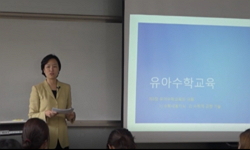The purpose of this study is to examine how much degree four-years-old children formed the concept of number and to examine whether there were difference between males and females or not in the formation of number concept. For this examination 48 fo...
http://chineseinput.net/에서 pinyin(병음)방식으로 중국어를 변환할 수 있습니다.
변환된 중국어를 복사하여 사용하시면 됩니다.
- 中文 을 입력하시려면 zhongwen을 입력하시고 space를누르시면됩니다.
- 北京 을 입력하시려면 beijing을 입력하시고 space를 누르시면 됩니다.
부가정보
다국어 초록 (Multilingual Abstract)
The purpose of this study is to examine how much degree four-years-old children formed the concept of number and to examine whether there were difference between males and females or not in the formation of number concept.
For this examination 48 four-years-old children were sampled radmdomly in the Kim Chon city kong kuk provine who consisted of 26males and 22females.
Each subject was interviewed individually for about ten minute the concept of number counting, one-to-one correspondence, ordering, number comparison, number conservation, number names, number presentation, cardinal number and ordinal number, which are subdimensions of the number concept.
Measurement tasks used in this study were Number Concept Task of Piaget and Interesting Number Playing Task of Lee Won Yong(1986).
The data was analyzed with Qui Square(X2) analysis.
The major result were as follows.
First, in the formation of number concept of four years-old children, only 29. 2 % of the subjects could count over fifteen in unnumber counting, 52.1 % in one-to-one correspondence, 14. 6 % in ordering in order, 14. 6 % in putting number between numbers orderly 8.3 % in ordering reversely, which show that most of four_years_old children cannot form number concept in the above dimensions, while 83. 3 % of the subject formed in number comparision which is higher than in other dimensions of th e number concept.
In number conservation, 21% of the subject could perform which show that the children could perform number conservation less than in other dimensions.
In number names, 50.0% of the subjects and in number presentation, only 20.8% of the subjects performed.
In cordined number and ordinal number, only 25 % of the subjects performed. From listed above, it could have been found that most of children could fom only number comparison and ordering number reversely.
Second, It could have been found that there were undifferences in the formation of number comcept between males and females.
목차 (Table of Contents)
- Ⅰ. 序論
- Ⅱ. 兒童의 수개념 발달 단계
- Ⅲ. 兒童의 수개념 내용
- Ⅳ. 硏究方法
- Ⅴ. 結果 및 해석
- Ⅰ. 序論
- Ⅱ. 兒童의 수개념 발달 단계
- Ⅲ. 兒童의 수개념 내용
- Ⅳ. 硏究方法
- Ⅴ. 結果 및 해석
- Ⅳ. 要約 및 結論
동일학술지(권/호) 다른 논문
-
돼지난소내 여포의 폐쇄과정중 과립세포의 hCG결합능의 변화
- 김천대학교
- 장철수
- 1989
-
유전완화법에 의한 노화된 폴리테트라 후로르에틸렌의 전기적 특성에 관한 연구
- 김천대학교
- 김성환
- 1989
-
한국치과기공사의 직장이동에 영향 미치는 제요인에 관한 연구
- 김천대학교
- 임병철
- 1989
-
炭鍍夫 塵肺症 患者의 杭核抗體와 류마토이드 因子에 關한 研究
- 김천대학교
- 서광석
- 1989




 RISS
RISS






